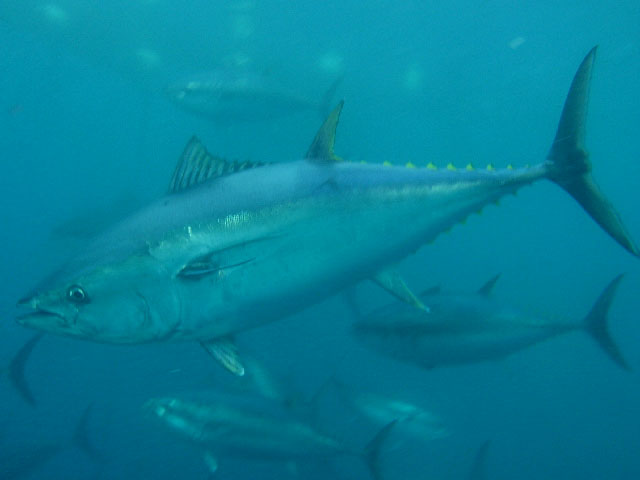| Scombridae (Mackerels, tunas, bonitos), subfamily: Scombrinae |
| 458 cm TL (male/unsexed); max.weight: 684 kg; max. reported age: 32 years |
|
pelagic-oceanic; brackish; marine; depth range 0 - 985 m, oceanodromous |
| Western Atlantic: Labrador and Newfoundland to Gulf of Mexico, and Caribbean Sea to Venezuela and Brazil. Eastern Atlantic: Lofoten Islands off Norway to Canary Islands, including the Mediterranean and the southern part of the Black Sea (Ref. 6769). Reported from Mauritania (Ref. 5377). There is a subpopulation off South Africa. Highly migratory species. |
|
Dorsal spines (total): 12-14; Dorsal soft rays (total): 13-15; Anal spines: 0-0; Anal soft rays: 13-16; Vertebrae: 39-39. A very large species, deepest near the middle of the first dorsal fin base. The second dorsal fin higher than the first; the pectoral fins are very short, less than 80% of head length. Swim bladder present. Lower sides and belly silvery white with colorless transverse lines alternated with rows of colorless dots. The first dorsal fin is yellow or bluish; the second reddish-brown; the anal fin and finlets dusky yellow and edged with black; the median caudal keel is black in adults. May be confused with several other tunas, these are typically much smaller and easily distinguished by specific patterns of stripes, bands or dots. |
| Oceanic but seasonally coming close to shore. They school by size, sometimes together with albacore, yellowfin, bigeye, skipjack etc. Visual predators (Ref. 88866) preying on small schooling fishes (anchovies, sauries, hakes) or on squids and red crabs. Live up to 40 years in the western Atlantic (Ref. 88822). Weight up to 900 kg (Ref. 88823). Eggs and larvae are pelagic (Ref. 6769). Juvenile growth is rapid (about 30 cm / year) but slower than in other tuna
and billfish species (Ref. 88867). Adult growth is considerably slower, with about 10 years needed to reach two thirds of maximum length. Become rare because of massive overfishing (Ref. 35388). |
|
Least Concern (LC); Date assessed: 15 January 2021 Ref. (130435)
|
| harmless |
Source and more info: www.fishbase.org. For personal, classroom, and other internal use only. Not for publication.
